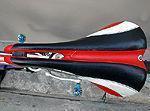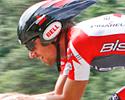
Recently on Cyclingnews.com |
Reviews
Koobi PRS saddle
By Tony Hawke
 |
What do you get when four guys from Minnesota buy every saddle they can get their hands on, ride them, decide what they like (or dislike) then rip them to bits? The possibilities are disturbing really, but in this case you get Koobi, a company that creates bike saddles. Distributing its wares predominantly over the web, Koobi has been producing its distinctively-styled saddles for about four years, sub-contracting the actual manufacturing to European saddle giant Selle Italia after a first year using a Taiwanese company. Six or eight pizza-fuelled trips to Italy later (the Koobi guys claim it was because they couldn't read anything else on the menu, in which case they really need to do Food Italian 101), and with the help of the engineers at Selle Italia, the Koobi design was improved to the point that it is at today.
 |
Koobi's latest creation is the suspended PRS saddle. The TLA stands for Personal Ride System, and the design brief was to create a suspension saddle that was light, simple and easily tunable. What Koobi has come up with is the result of around two years of testing and is based on a standard Koobi body, but where the rails would usually join directly to the rear of the body, there is a pair of elastomer bumpers that provide around 10mm of travel. The cover is made from 11 pieces of red, white and black leather formed and stitched together into the distinctive Koobi shape. Rails are either manganese (claimed weight: 320g) or titanium alloy (299g). There is also a version with titanium alloy tubing rails, Kevlar corners and a subdued colour scheme in the works which is said to weigh around 265 grams.
 |
Setting up the PRS is slightly more involved than for normal saddles. First step is to decide which elastomers to use and change them if you need to. Three different pairs of elastomers are included, blue, red and yellow with red being 20 percent harder than yellow and blue being 20 percent harder again. Next, fit the saddle to your seatpost, making sure that there is 25mm clearance between the highest point of your seat post and the saddle body. You need to do this so that there is enough room for the saddle to move up and down on the elastomers without it hitting the post. During the PRS's development, there were a number of cases of the rails breaking, and these were traced to the saddle body bottoming out on the seat post and transferring the forces that would normally be absorbed by the elastomers directly through one of the rails, causing it to break. Koobi also recommend that you set their saddles so that the nose is dropped from 0 to 10 degrees to make sure that your weight is carried on your seat bones.
 |
Now, to the fun bit. Actually riding it. I'd never ridden anything but a conventional bike saddle, so I was a bit skeptical whether the groove down the center was actually any use or if it was just something that looked cool and tried to justify a higher price. My first ride said that maybe it was some use after all. Usually my first ride on a new saddle is an exercise in pain, not so with the Koobi, it was actually quite comfortable. The second ride, however, was much more interesting. After about five minutes, I hurt in places I am very fond of in ways I didn't know I could hurt. My only explanation for this is that I must have been sitting on it at an odd angle as it was a one-off and hasn't happened since.
Do the bouncy bits at the rear make a difference? It depends on your bike. If you ride a hardtail or rigid bike, then yes. If you ride a dually, the difference isn't noticeable. Initially, you spend a lot of time looking at the rear end of your bike trying to work out what's feeling so weird, then you get used to it and enjoy the fact that most of the little bumps disappear and the bigger ones have the edge taken off them. 10mm of travel can't do a whole lot to smooth out the trail, but it can do enough in combination with a very well shaped saddle to make a hardtail much more comfortable on those longer rides.
 |
Changing the elastomers was a no-brainer, even after the booklet explaining how to go about the job was 'filed' by John the Tech Ed (It's on my desk somewhere, honest - JS). Simply remove the covers, which protect the bolts from mud thrown up by your rear tyre; unscrew the bolts which hold everything together; pop the spacers under the elastomers out and finally, you can take the elastomers themselves out. Putting it all back together is simply the reverse of the above.
Would I buy this saddle? Well, I'm just about to ride a 12 hour race solo using it, so I guess the answer is a resounding 'yes' Add to the great feel of the saddle the fact that Koobi has donated a significant amount of money to IMBA to help ensure continued trail access for mountain bikers and I think you have a great saddle which is not only comfy, but you get a warm glow from the fact that your purchase will help mountain bikers in their struggle for equitable access.
The only thing that stops this model getting full marks is its lack of any protection on the corners to prevent damage in the inevitable scrapes.
Weights: Manganese rails: 320g, Titanium rails: 299g, hollow Titanium
rails: 265g (claimed weights)
Price guide: $99.95 (USA)
Pro: Great shape, bouncy bits take a little bit of sting out of the
trail without adding too much weight, colour scheme (if it matches your bike.)
Easy to tune to your weight.
Con: Colour scheme
More information: Koobi's
website
Cyclingnews Rating: ![]()
What do you think of the Koobi PRS? Let us know

